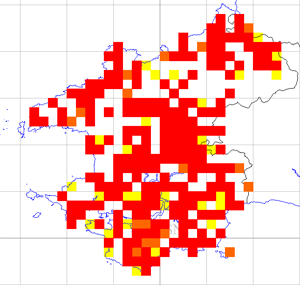House Martin - 2003-07
 Thursday, May 10, 2012 at 9:06PM
Thursday, May 10, 2012 at 9:06PM Most House Martins arrive in Pembrokeshire between early and mid April, although there have been sightings as early as February.
House martins are highly dependent on buildings for nest sites with up to 99% of the breeding population building mud nests, or utilising artificial nest boxes positioned high-up on walls beneath over-hanging eaves, which protect the nest and its contents from adverse weather. In Pembrokeshire, a small proportion of House Martins nest in sea caves, or beneath over-hangs on sea cliffs. Colonies can be found, for example nesting in/on sea cliffs to the south of Ceibwr; at Nolton Haven and on the Castlemartin coast.
The 1984-88 tetrad survey confirmed that House Martins are widely distributed as a breeding species across the county. A comparison between this and the 2003-07 tetrad survey suggests a stable or slightly increasing breeding population:
The tetrad map illustrates where localised changes in the distribution of breeding House Martins have occurred in between the two tetrad surveys. House Martins are absent as a breeding species from all the offshore islands, with the exception of Caldey Island, where it was recorded as “probable breeding” during the 2003-07 tetrad survey. They are also absent from the tops of the Preseli Hills and from heavily wooded areas.
Whilst the breeding population of House Martins has generally remained stable or increased overall, localised losses from some tetrads could be due to a number of factors, which may also hold the key to their future as a breeding species in the county. These factors include future availability of suitable nest sites. It is vital that building renovations, as well as new buildings take account of their nesting requirements if they are to continue to grace our skies. The availability of mud for nest-building is also vital as this resource can be easily lost e.g. as a result of tidying up muddy seepages, hollows and puddles. A single source of mud may supply the entire House Martin population on farms or in small settlements. Other key factors include abundance and distribution of aerial insects.
Following the 1984-88 tetrad survey, the total breeding population of House Martins in the county was estimated to be around 4,000 pairs (an average density of 20 pairs per tetrad was assumed).On this basis, an increase of 16% of tetrads where breeding was confirmed during the 2003-07 tetrad survey suggests a total breeding population of about 4,700 pairs.
Jane Hodges

Fieldwork 2003-07 (based on 490 tetrads)
Red = breeding confirmed = 235
Orange = breeding probable = 17
Yellow = breeding possible = not included
Total tetrads in which registered = 252 (51.4%)
 JEH,
JEH,  PBBA 2003-7 in
PBBA 2003-7 in  House Martin
House Martin 

Reader Comments